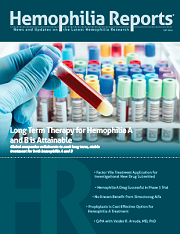Publication
Article
Q&A with Valder R. Arruda, MD, PhD
Author(s):
Dr. Arruda is a hematology researcher at The Children's Hospital of Philadelphia and an associate professor of Pediatrics in the Perelman School of Medicine at the University of Pennsylvania. His laboratory focuses on gene-based strategies for the treatment of bleeding and thrombotic diseases.

Valder R. Arruda, MD, PhD, is a hematology researcher at The Children’s Hospital of Philadelphia and an associate professor of Pediatrics in the Perelman School of Medicine at the University of Pennsylvania. His laboratory focuses on gene-based strategies for the treatment of bleeding and thrombotic diseases.
Can you first provide some background information on the FIX-Padua discovery?
A young man about 23 years old with very high levels of factor IX (FIX) and thrombosis was discovered by a colleague of mine in Italy. When we discussed the patient, we noted his FIX levels were at about 700 percent of the normal, while healthy patients range between 60-70 and 120-130 percent of the normal range. Only his FIX levels were elevated, but nothing else was out of the ordinary. His mother was around 300-400 percent elevated FIX levels; however she never had thrombosis, even during pregnancy. Of the young man’s 2 brothers, one was completely normal and the other had higher levels of FIX. No other citizens in the Padua area demonstrated these symptoms. It was a very rare mutation. After the second brother turned 14 years old, he developed thrombosis as well.
How did you apply the FIX-Padua work to the most recent study on hemophilic dogs?
We went out to develop this vector system to develop the FIX Padua in the canine gene and delivered that to the dogs, which we believed were naïve to the canine FIX protein. The dogs in our study had severe hemophilia B, which is common to happen spontaneously in dogs. In any dog, not just a hemophilic dog, they develop inhibitors to the human proteins because their bodies don’t recognize it. We knew it was possible to eradicate antibodies in hemophilia through gene therapy from a 2010 paper, but this was the first time dogs were being introduced to the human protein. In the first and third dogs, it went very well.
Did you anticipate the ability for FIX-Padua to be successful in the 3 dogs or were you surprised by the findings (particularly the third dog which had developed inhibitors already, Wiley)?
Wiley (the second dog) took almost 3 years to reach levels close to 200-250 percent of the normal, but he was expressing 20 percent of the normal antigen and increased 8-10 fold. His antibodies went away in less than 100 days. Wiley turned out to be a dog which had already been introduced to the human factor and had developed an inhibitor. It was the first time that anyone had eradicated an inhibitor in a dog with pre existing antibodies before gene therapy, which was a surprise finding. It took a while for this to occur in comparison to Factor XIII (FXIII) dogs, which were a bit faster, but the current literature hints that FIX inhibitors are a lot more of a challenge.
Is this process safe and efficacious for hemophilia B patients only, or can the results be simulated in hemophilia A patients as well?
For the implications for hemophilia A, I don’t think anyone can say right now. We understand that FXIII and the Padua mutation are similar on the surface. In terms of factor 8, if this is true, if we try to find the mechanism and this proves to be true, you can question what the reason is that modifies factor 8 is more interactive with factor 9 will also be better. There’s a potential, but it’s a stretch. It depends on the mechanism which we are trying to work to understand.
A press release stated that 2 studies are engaging in or thinking about using these methods for human subjects. Do you believe that's the next step, or should this be tested in a wider population of animal models before it gets tested in human subjects?
There is one ongoing trial with FIX Padua at UNC Chapel Hill, where they are injecting 5 or 6 patients and there is no antibody to the Padua in any of those patients. The safety data in question is not immunogenic in the small number of patients. Sometimes we do a clinical trial of gene therapy, and we only take people that have no history of inhibitors to either FXIII or FIX. They are already tolerant. The good thing is that in expressing Padua they show they are tolerant to the wild type which doesn’t change the immunogenicity — which is a good thing.
A second trial that is going to begin soon is being done by a spinoff company of The Children’s Hospital of Philadelphia called Spark Therapeutics. They are using Padua as well.
What can other researchers learn from your study using hemophilic dogs?
I think we don’t need a large number of animals. We just need to do the right experiments. It’s not very practical to have too many animals. They are very fragile and they require 24/ 7 observance. You can’t inject 20 dogs. But if you do the right experiments, you can learn quite a lot of lessons like we learned from these 3 dogs.






